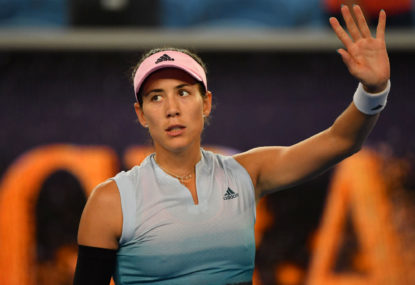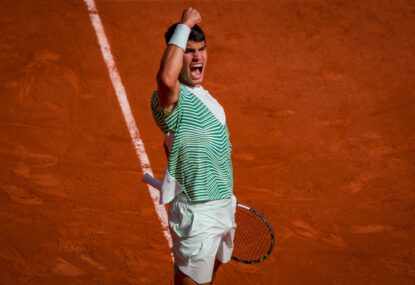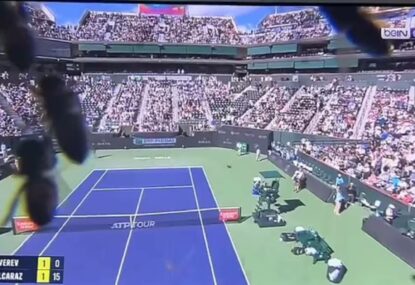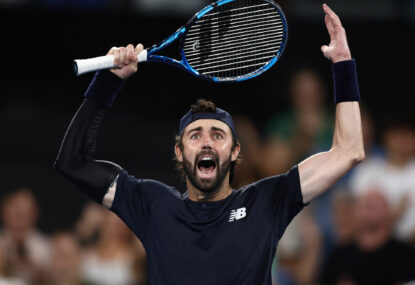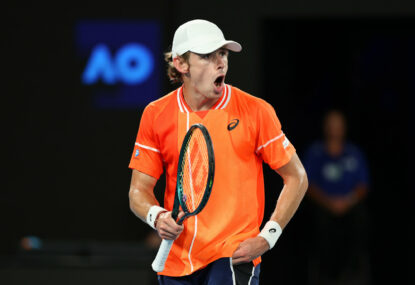After losing a Grand Slam semi-final, it’s hard to figure out who was the best loser, and it shouldn’t depend on how he or she played in the semi-finals.
The Olympic tennis tournament already has a third-place play-off which determines who wins the Bronze Medal. Last year, Juan Martin del Potro defeated Novak Djokovic to claim third-place whilst Victoria Azarenka did likewise to Maria Kirilenko.
This is the basis of my debate as to whether third place matches should be introduced at the Grand Slams. If this concept had existed in the last few years, we would have come up with these interesting match-ups:
* Novak Djokovic vs Jo-Wilfried Tsonga, 2013 French Open and Wimbledon 2012
* Maria Sharapova vs Sara Errani, 2012 US Open
* Petra Kvitova vs Samantha Stosur, 2012 French Open
* Roger Federer vs Andy Murray, 2012 Australian Open and 2011 US Open
* Jo-Wilfried Tsonga vs Andy Murray, Wimbledon 2011
* Novak Djokovic vs Andy Murray, 2011 French Open and Wimbledon 2010
* Caroline Wozniacki vs Vera Zvonareva, 2011 Australian Open
* Jelena Jankovic vs Elena Dementieva, 2010 French Open
* Li Na vs Zheng Jie, 2010 Australian Open
* Novak Djokovic vs Rafael Nadal, 2008 and 2009 US Opens
* Elena Dementieva vs Dinara Safina, Wimbledon 2009 and 2008 US Open
* Elena Dementieva vs Vera Zvonareva, 2009 Australian Open
* Marat Safin vs Rainer Schuettler, Wimbledon 2008
* Roger Federer vs Rafael Nadal, 2008 Australian Open
* Justine Henin vs Ana Ivanovic, Wimbledon 2007
* Jelena Jankovic vs Maria Sharapova, 2007 French Open
* Nikolay Davydenko vs Mikhail Youzhny, 2006 US Open
* Kim Clijsters vs Maria Sharapova, 2006 Australian Open and Wimbledon
* Maria Sharapova vs Elena Dementieva, 2005 US Open
* Maria Sharapova vs Amelie Mauresmo, Wimbledon 2005
* Roger Federer vs Andy Roddick, 2005 Australian Open
* Lindsay Davenport vs Jennifer Capriati, 2004 US Open
* Lindsay Davenport vs Amelie Mauresmo, Wimbledon 2004
* Andre Agassi vs Juan Carlos Ferrero, 2004 Australian Open
Here, I would like to look at some interesting matches in particular which could have occurred:
Novak Djokovic vs Jo-Wilfried Tsonga, 2013 French Open
Apart from the French Open final which will be played out on Sunday between Rafael Nadal and David Ferrer, this was the other final choice that the fans would have wanted.
Personally, I would have loved to see these two men fight out the French Open final this Sunday, but instead it will be an all-Spanish affair.
Djokovic won his first Grand Slam title at the 2008 Australian Open by defeating Tsonga in the final.
Tsonga had made a giant-killing run through the draw, upsetting Andy Murray in the first round and then devastating Rafael Nadal in the semis with a powerful performance rarely witnessed against a top player such as Nadal.
Since then, the rivalry between Djokovic and Tsonga has heated up, none more so than their five meetings last year.
In the quarter-finals of the French Open last year, Tsonga held four match points against serve in the fourth set before capitulating to lose in five sets. This would be the closest he would come to beating Djokovic for the first time since 2010.
Had the French Open final been contested between these two, appropriately Djokovic would have been able to complete his Career Grand Slam against the same opponent whom he defeated to win his first Grand Slam title.
Maria Sharapova vs Sara Errani, 2012 US Open
In the four months leading up to the US Open, Sara Errani had shown a lot of improvement in her game, highlighted by an unexpected run to the French Open final, where she took out three former Major champions and in the process crack the top ten for the first time.
However, there to stop her from completing the biggest miracle in women’s tennis was a woman who had to overcome a career threatening shoulder injury and a dip down to as low as World No. 126 in the rankings to reach her first French Open final.
Since winning the 2008 Australian Open, the French Open title had eluded Maria Sharapova for over four years.
In 2008, she held a match point against eventual finalist Dinara Safina in the fourth round before losing, and in 2011 was stopped in the semi-finals by eventual champion Li Na.
But in the same way that Roger Federer completed his Career Grand Slam by defeating Robin Soderling, Sharapova completed her own set by defeating Errani in straight sets.
Three months later at the US Open, they would end up being the two losing semi-finalists; had these two fought out the decider, it would have been another one-sided affair instead of the eventual three-set thriller we were treated to by Serena Williams and Victoria Azarenka.
Roger Federer vs Andy Murray, 2011 US Open and 2012 Australian Open
In the time period between May 2011 and July 2012, these two players have had to play second fiddle to the dominant rivalry at the time that was Novak Djokovic and Rafael Nadal.
Whilst those two fought out four consecutive Grand Slam finals between Wimbledon in 2011 and the epic 2012 Australian Open, Federer and Murray have been forced to endure lower-profile runs through to the semi-finals.
In 2011, the US Open final could so easily have been between Federer and Nadal, but, as he did in 2010, Djokovic saved match points to deny Federer his date with destiny in the final.
It was almost the same story in Australia in 2012. Federer and Nadal were put into the same half of the draw at a Major for the first time since the 2005 French Open, whilst Murray was assigned to Novak Djokovic’s half, preventing any chance of a repeat of the 2011 one-sided final which was won by the Serb.
It made for two potentially block-busting semi-finals.
Nadal overcame Federer in four whilst Murray pushed Novak Djokovic all the way before losing in five sets. Had the third place match taken place here, another epic would have been guaranteed.
Caroline Wozniacki vs Vera Zvonareva, 2011 Australian Open
These two women started 2011 as the top two women in the world, but both were not considered to be the favourites for the 2011 Australian Open, with all the attention instead being directed towards Kim Clijsters.
The rivalry between Wozniacki and Zvonareva was there for all to see in the second half of 2010, when they met five times, including in the finals of the Rogers Cup and China Open (both won by Wozniacki), the US Open semi-finals (won by Zvonareva) and the semi-finals of the year-end championships in a match which would decide who would finish 2010 ranked World No. 1 (won by Wozniacki).
And it looked like this rivalry would continue into the Australian Open. One way or another, Kim Clijsters would have had to be assigned to either half of the draw and she eventually landed in Zvonareva’s half.
Thus, the projected semi-final would produce a rematch of the one-sided 2010 US Open final which Clijsters won 6-2, 6-1.
Wozniacki and Zvonareva both advanced to the semi-finals, but both lost in contrasting circumstances.
Wozniacki had a match point against Li Na at 5-4 in the second set before the Chinese came back to win, whilst Zvonareva, as she was in New York on September 11 the year previous, was once again outclassed by Clijsters.
After the Australian Open, Wozniacki and Zvonareva would only meet twice more, but they would meet in the Qatar Open final a month later with the Russian winning.
Wozniacki has also since lost her World No. 1 ranking, whilst Zvonareva’s career is now in doubt after shoulder surgery kept her sidelined since August last year.
Just imagine what could have been had this final taken place – the rivalry would have been as fierce as ever.
Li Na vs Zheng Jie, 2010 Australian Open
The 2010 Australian Open final was best known for the performances of these two players from China.
Li Na came to prominence at the 2009 US Open, where she reached the quarter-finals before losing to eventual champion Kim Clijsters. Zheng Jie, on the other hand, was coming back from injury which saw her ranking drop to outside the Top 200.
But a stunning run to the semi-finals at Wimbledon in 2008 saw her recognised as the WTA Comeback Player that year.
Both players flew under the radar in their runs to the final four in Australia in 2010, a tournament which was ravaged by the early eliminations of glamour girls Maria Sharapova, Ana Ivanovic, Elena Dementieva and Jelena Jankovic, as well as comeback player Kim Clijsters, who was thrashed in the third round by Nadia Petrova.
Li Na upset Caroline Wozniacki in the fourth round (she would do so again 12 months later), and went on to reach her first Grand Slam semi-final, losing to World No. 1 and eventual champion Serena Williams.
Zheng Jie knocked out Marion Bartoli, Alona Bondarenko (who had upset Jankovic in the third round) and Maria Kirilenko (who had beaten Maria Sharapova in the first round), before being swamped by Justine Henin (who had eliminated Dementieva in the second round).
Whilst the final was contested between Williams and Henin, two rivals whose best matches against each other came in 2007, imagine what could have been had the two Chinese women met.
A first-time Chinese Grand Slam champion would have been guaranteed, however, Li Na would not have to wait long for her glory, winning Roland Garros in 2011.
Zheng, on the other hand, hasn’t reached the same heights since, her best result since then being a fourth round loss to Sara Errani at last year’s Australian Open.
Novak Djokovic vs Rafael Nadal, 2008 and 2009 US Opens
This wasn’t the biggest rivalry in men’s tennis back then, as Djokovic and Nadal continued to play second fiddle to Federer towards the end of the noughties.
Nadal had, though, inherited the World No. 1 ranking for the first time when he entered the 2008 US Open, and was seen by many as a favourite for the US Open title, well, that was until Andy Murray stopped him in his tracks in the semi-finals.
Then, in 2009, as the third seed, he once again reached the semi-finals, before being swamped by eventual champion Juan Martin del Potro there.
Djokovic, on the other hand, after losing to Roger Federer in the 2007 final, was assigned to the great Swiss’ half for the four editions of the US Open that followed.
Djokovic was unable to beat Federer in 2008 or 2009, but in the latter semi-final, he was able to keep up with Federer, being only broken twice in the entire match (the last game of the last two sets) despite losing in straight sets.
The third place matches that could potentially have taken place in these two years may as well have decided who was best out of Nadal and Djokovic, and even though Nadal was clearly the better of the two, he had never reached the US Open final to that point, whilst Djokovic had (2007).
Elena Dementieva vs Dinara Safina, Wimbledon 2009 and 2008 US Open
Over the last 12 months, Elena Dementieva and Dinara Safina had shown a lot of improvement.
Safina had her breakthrough during the 2008 clay court season, where she won the title in Berlin taking out Justine Henin, Serena Williams and Victoria Azarenka en route to defeating Dementieva in the final.
Then, she followed it up by reaching the French Open final in Paris, taking out Maria Sharapova, Dementieva and then Svetlana Kuznetsova before falling to Ana Ivanovic in the final.
Dementieva, on the other hand, appeared to enjoy a career resurgence after 18 months in the wilderness.
From there, the rivalry between Dementieva and Safina heated up. Dementieva gained her revenge over Safina to win the Gold Medal at the Beijing Olympics, and both would reach the semi-finals of the 2008 US Open, falling one match short of a rematch in the final, which could have guaranteed a first-time Grand Slam champion.
Both then fell to Serena Williams at the 2009 Australian Open, thus denying the tournament another Russian champion after Maria Sharapova won the 2008 edition.
Both players continued to improve after that with Safina reaching World No. 1 and Dementieva reaching a career high ranking of World No. 3.
Perhaps the final chapter of this rivalry could have come in the final of Wimbledon in 2009. Instead, both were upstaged by the Williams sisters in contrasting circumstances; Dementieva held a match point against Serena before losing in three sets, whilst Safina was wiped out by Venus, a defeat which appeared to mark the beginning of Safina’s fall from grace.
The third place match could have determined which of the two would have been the best Russian after all, in the face of Maria Sharapova’s comeback after shoulder surgery derailed her career.
Roger Federer vs Rafael Nadal, 2008 Australian Open
For so long Roger Federer and Rafael Nadal were seen as the two men to beat at Grand Slam tournaments.
They appeared on track for what could have been their first Grand Slam final against each other outside of Europe, well, that was until Novak Djokovic and Jo-Wilfried Tsonga ruined their plans.
Prior to the 2008 Australian Open, Nadal had yet to even reach a Grand Slam final, let alone a semi-final, outside of Europe or on hard court.
But by defeating Jarkko Nieminen in the quarter-finals, that all changed. This was the first year in which the plexicushion surface was implemented, which may have led to Nadal’s improved performances on hard courts.
Federer on the other hand, in his bid for a third straight title in Australia, was almost derailed in the third round by Janko Tipsarevic.
He was pushed to five sets and the final set went 10-8, at stages during that epic final set, Federer was in danger of making his earliest exit from a Major since 2004.
Whilst he eventually went on to reach the semi-finals, unfortunately he ran out of puff in the semi-finals and was rather easily beaten in the semi-finals by Novak Djokovic, who went on to win his first Grand Slam title.
Just imagine this, though, had Federer and Nadal met in the third-place match (or the final), the potential was there for an epic match of proportions.
Justine Henin vs Ana Ivanovic, Wimbledon 2007
The year 2007 was all about two women: Justine Henin, the dominant force, and Ana Ivanovic, one of the biggest improvers on the WTA Tour.
Henin was in career best form, this coming after the breakdown of her marriage which forced her to miss the Australian Open and her World No. 1 ranking (briefly) at the start of the year.
Among the highlights of her dominant season included two Grand Slam titles, the French and US Open titles, the year-end championships titles and her dominance of Serbia’s top two women, Jelena Jankovic and Ana Ivanovic, winning a combined nine matches against them for no losses.
Henin and Ivanovic met in the final of the French Open. Henin was in top form, having not dropped a set en route to reaching the final, whilst Ivanovic entered the championship match having taken down Svetlana Kuznetsova and Maria Sharapova en route.
The potential was there for a thrilling match, but it painfully turned out to be very one-sided. Henin won 6-1, 6-2, the result contributing to a curse which seems to plague Ivanovic, called the ‘Belgian curse’ (as of 2013, she is 0-14 against Belgian opposition).
Four weeks later, they appeared headed for another showdown in the Wimbledon final, but both were stopped in their tracks, one by the most unlikeliest of finalists, whilst the other was expected to be stopped, anyway.
Henin wasn’t expected to be challenged by Marion Bartoli and even after winning the first set 6-1, the Belgian appeared on track for a third final at SW19.
But the Frenchwoman, inspired by the presence of her favourite actor, Pierce Brosnan, in the stands, came back from the canvas to win in three sets.
Ivanovic on the other hand, drew Venus Williams in her first Wimbledon semi-final. The Serb was never going to challenge Venus, and, not surprisingly, was beaten in straight sets.
Despite these losses, Henin and Ivanovic were able to back up their successful clay court campaigns with their runs to the semi-finals at the All England Club, and were the last pair of French Open finalists to back up their clay court campaigns with strong results at Wimbledon, reaching at least the semi-finals.
Roger Federer vs Andy Roddick, 2005 Australian Open
Before the start of this tournament all the money was on Federer and Roddick to continue their rivalry from where they left off in 2004.
The pair had contested the Wimbledon final, the first of three between the pair (with another two following in 2005 and 2009), and were clearly the best two players in the world all year.
And they appeared on track for a meeting in the final of the Australian Open to start the year, well, that was until Marat Safin and Lleyton Hewitt scuppered their plans.
In a rematch of the 2004 final, Federer had Safin on the ropes in the fourth set, having a match point which would have sent him into the final, but a tweener just missed and Safin was eventually let off the hook.
The Russian went on to reach the final and defeated Hewitt to take the title.
Roddick on the other hand had it tough against Hewitt – despite slamming home four aces in a row to take the first set, the American lost his way for the rest of the match and ended up losing in four sets – the score in the fourth set was 6-1 in Hewitt’s favour.
Whilst they would reach the final at SW19 six months later, that would be the temporary end to their rivalry as Rafael Nadal started to become the man playing second fiddle to Federer.
The rivalry between Federer and Roddick eventually ended up being one of the most one-sided in tennis history (Federer led the head-to-head 21-3), but Roddick snuck in a victory in their final meeting, in Miami last year.
So, with all those matches that could have taken place, the potential was there for the tournaments to continue to produce thrilling or one-sided matches, depending on whose side you are on.
Many will also say that these matches could turn out to be meaningless, as they have just lost the semi-finals and thus have nothing to play for. Rankings-wise, though, it could be important.
Under the current rankings system, there is a large margin between the points awarded to finalists and semi-finalists. Semi-finalists earn 720 points, whilst finalists earn 1,400 points.
That’s a gap of 680 points, in comparison to quarter-finalists who earn 500, a gap of 220 between them and the semi-finalists.
Taking the third-place matches into account, the winner of the third-place match would earn 1,000 points, whilst the loser would still remain on 720.
This would reduce the gap between the finalists’ points and the semi-finalists’ points by almost half.






























































































